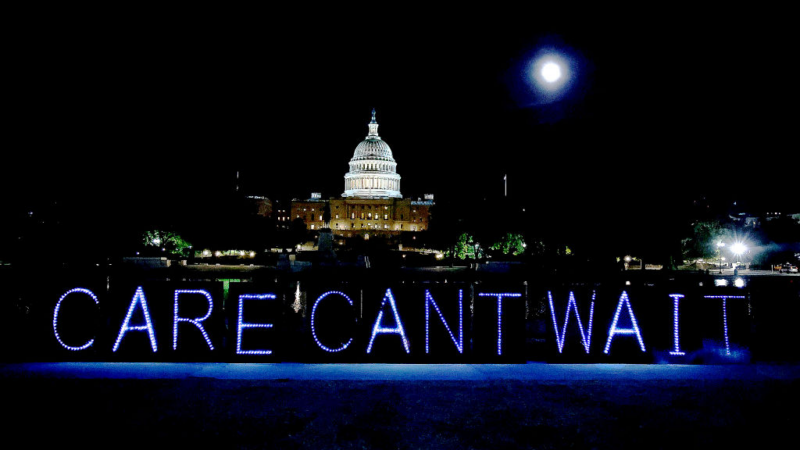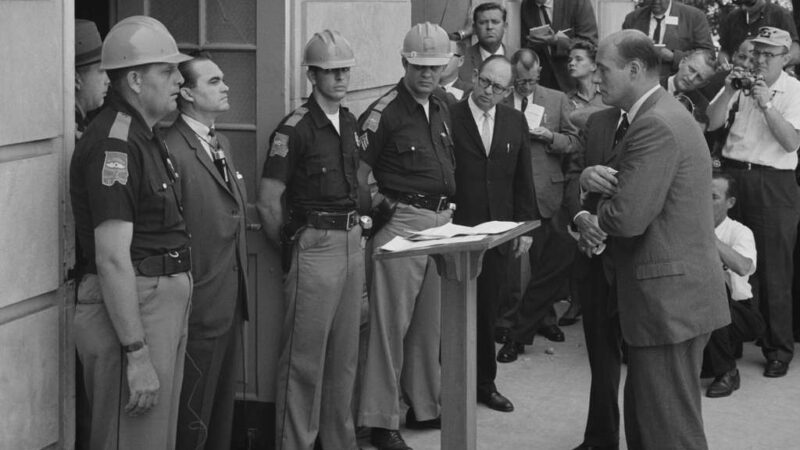Has the Billboard Hot 100 caught the Holy Ghost?
For the first time, multiple Christian musicians are charting on the Billboard Hot 100 at the same time — and staying there for weeks. Has the mainstream music industry found Jesus Christ?
Brittany talks with University of Michigan-Dearborn Professor Emerita Dr. Deborah Smith Pollard and Christianity Today reporter Kelsey Kramer McGinnis to understand the multi-million dollar machine behind the Christian Contemporary Music genre. They unpack who gets shut out, and why this holy crusade on the charts has the potential to impact your listening habits.
Episode Highlights:
What exactly is Christian contemporary music, or CCM?
KELSEY KRAMER MCGINNIS: I tend to talk about it like an industry. So CCM is not a genre so much as it is a media ecosystem that really became popular in the 1980s and 1990s, at least popular in the way that it is now. So this music mirrors what you’d hear on mainstream radio in terms of style and characteristics. But you wouldn’t have the objectionable content. So think, you know, no sex, no drugs, those kinds of things.
DEBORAH SMITH POLLARD: Certainly, and when we look at Maverick City Music and Elevation Worship, when we look at CeCe Winans and Dante Bowe, we see that there are African Americans who sing both gospel and CCM.
What kind of CCM is hitting on the charts right now?
KRAMER MCGINNIS: I call it Barstool conversion rock. It’s sort of this interesting web of things between masculinity, kind of conservative politics, and country [music]. I mean, you even have Jelly Roll, Shaboozey, Alex Warren, a whole collection of, I would add, primarily male artists making this kind of faith-flavored music and really making breakthroughs with it.
How do these big megachurches, like Hillsong or Bethel, play into the economy of this worship music?
KRAMER MCGINNIS: For at least 20 years or so now, that megachurch experience has been driving the style, format and intended effect of a lot of CCM, what I would call contemporary worship music. You can find resources we call multitracks or stems that are created for churches to basically plug and play. There is a whole industry underneath this music that exists purely to help churches recreate the experience of being at one of these megachurches as closely as they can. Even if I go to a church of, you know, a hundred and fifty people on a Sunday morning, if I don’t have 20 musicians on stage, I can buy a couple synth parts. I can buy an electric guitar part. I can buy background vocals. I can buy choir effect. I can purchase lighting, all of these pieces that make it closer to what you would see when you watch a recording by Bethel.
How do we know what kind of music is being played in these churches?
KRAMER MCGINNIS: Christian Copyright Licensing International tracks the use of music across churches. And there’s a reason why so much of the music in there is tracking what’s being used in white churches, and there’s not as much music that is regularly used by Black churches there. So all of this is shaping the Christian music industry and the sounds of popular Christian music as we watch this all unfold.
Is there the same economic opportunity in gospel as there is in Contemporary worship music?
SMITH POLLARD: I doubt it because I’ve never been to a Black church where there’ve been the lyrics on the screen, other than the lyrics for a hymn or the lyrics for a Negro spiritual, OK? So that’s why I would say 99.9% of them are not having to pay CCLI for using that particular music.
Why do you think understanding this current CCM boom is something that’s important for people who are outside of Christianity?
KRAMER MCGINNIS: A lot of this music is made by men. And a lot of it is a little bit country-flavored as well. And to the extent that those things are all connected, what might be happening there? Why might this music be resonating? What does it tell us about masculinity and, you know, conservative politics and the search for faith at this moment? We have an administration right now that talks very openly about wanting to fight against anti-Christian bias in the world. And it’s hard not to look at that and then look at celebration over Christian music featuring prominently on “American Idol” and seeing a certain segment of evangelicals feeling like, this is our moment.
Transcript:
BRITTANY LUSE, HOST:
Hello, hello. I’m Brittany Luse, and you’re listening to IT’S BEEN A MINUTE from NPR, a show about what’s going on in culture and why it doesn’t happen by accident.
(SOUNDBITE OF MUSIC)
LUSE: A few years ago, songs that were topping the Billboard Hot 100 might have sounded like this…
(SOUNDBITE OF SONG, “ABOUT DAMN TIME”)
LIZZO: (Singing) It’s about damn time.
LUSE: …Or this.
(SOUNDBITE OF SONG, “SAVAGE”)
MEGAN THEE STALLION: (Singing) I’m a savage.
LUSE: But lately, the songs that are getting the most replays are sounding more like this…
(SOUNDBITE OF SONG, “ORDINARY”)
ALEX WARREN: (Singing) Hopeless hallelujah on this side of heaven’s gate.
LUSE: …And a little further down on the charts, like this.
(SOUNDBITE OF SONG, “HARD FOUGHT HALLELUJAH”)
BRANDON LAKE: (Singing) It-is-well hallelujah, whoa.
LUSE: Are you picking up what I’m putting down?
(SOUNDBITE OF MUSIC)
LUSE: The Hot 100 has been getting a heavy dose of piety and prayer lately.
KELSEY KRAMER MCGINNIS: It’s an unusual thing for multiple Christian artists to be on the Billboard Hot 100 at the same time, and that’s happened right now.
LUSE: That’s Kelsey Kramer McGinnis.
KRAMER MCGINNIS: I am a reporter for Christianity Today covering music and congregational worship practices, and I’m an adjunct professor at Grand View University.
LUSE: She even has a name for this unusual amount of faith-flavored music on the charts.
KRAMER MCGINNIS: Barstool conversion rock. It’s sort of this, like, interesting web of things between masculinity, kind of conservative politics, country.
LUSE: It’s the type of music two guys can share a beer over and reflect on the simple things in life, like the goodness of God.
KRAMER MCGINNIS: I mean, you even have, you know, Jelly Roll, Shaboozey, Alex Warren, a whole collection of, I would add, primarily male artists making this kind of faith-flavored music and really making breakthroughs with it.
LUSE: And it’s not just the Hot 100. Over the past years, Spotify streams of Christian contemporary music have grown 60%. The market and appetite for Christian music seems to be swelling. Here’s another example.
(SOUNDBITE OF TV SHOW, “AMERICAN IDOL”)
RYAN SEACREST: The winner of “American Idol” is Jamal Roberts.
(CHEERING)
DEBORAH SMITH POLLARD: A gospel singer is the one who won.
LUSE: That’s Dr. Deborah Smith Pollard.
SMITH POLLARD: Professor emerita from University of Michigan-Dearborn. But I’m still on the radio at one of the iHeart stations here in Detroit, Mix 92.3.
LUSE: She’s a gospel music historian and expert, and she’s seen how even gospel artists are getting their piece of the mainstream pie. And she wants us to pay attention to Jamal Roberts’ “American Idol” win.
SMITH POLLARD: Because there’s no way in the United States that he would have won if thousands and thousands of people who didn’t even look like him didn’t vote for him. But they did vote for him because of his dynamic style.
LUSE: Today, Deborah and Kelsey join me to break down the multimillion-dollar machine behind the Christian contemporary music genre. Who gets shut out? And why this holy crusade on the charts has the potential to impact your listening habits.
(SOUNDBITE OF MUSIC)
LUSE: OK. So I need a little bit of context. So to start us off, what exactly is Christian contemporary music, or CCM?
KRAMER MCGINNIS: Gosh, that’s such a good question. So I tend to talk about it like an industry. So CCM is not a genre so much as it is, like, a media ecosystem that really became popular in the 1980s and 1990s, at least popular in the way that it is now. So this music mirrors what you’d hear on mainstream radio in terms of, like, style and characteristic.
LUSE: OK.
KRAMER MCGINNIS: But you wouldn’t have the objectionable content. So think, you know, no sex, no drugs, those kinds of things.
LUSE: Oh, like Amy Grant?
KRAMER MCGINNIS: Yes, like Amy Grant.
LUSE: This is kind of a throwback reference, but I know she started in contemporary Christian music and then crossed over into mainstream pop with songs like “Baby, Baby.”
(SOUNDBITE OF SONG, “BABY, BABY”)
AMY GRANT: (Singing) Baby, baby, the stars are shining for you. And just like me, I’m sure that they adore you.
KRAMER MCGINNIS: Amy Grant, Michael W. Smith – I mean, names that people might not know anymore, but those are, like, the big names, and it’s growth coincided with this kind of moment of cultural panic that brought together a lot of white evangelicals. Think Moral Majority moment, politically speaking. And this industry really rose up because it offered an alternative to MTV, an alternative to Hot Radio. You had parents that were worried. Oh, the teens are listening to this music that has all this objectionable content. Here is this kind of clean Christian version of it.
LUSE: I see. OK, OK, OK. And I want to hear from you, too, on this, Deborah. How do you see contemporary Christian music, or CCM, kind of fitting into, like, the broader Christian music landscape?
SMITH POLLARD: Certainly, when we look at Maverick City and Elevation Worship, when we look at CeCe Winans and Dante Bowe, we see that there are African Americans who sing both gospel and CCM.
LUSE: Maverick City and Elevation Worship, of course, being two music collectives that make contemporary Christian music.
SMITH POLLARD: Yeah, and which is not always applauded by everybody. And yet, when you go to YouTube and look at how many views they’ve received, they’re beyond millions, like, tens of millions because people embrace their songs. Because in both Elevation Worship and in Maverick City, those are cross-cultural groups. They’re both Black and white, OK?
LUSE: And to be clear, contemporary gospel music is also a type of CCM, but I really start noticing the differences between CCM and that traditional gospel sound when I hear crossover artists.
SMITH POLLARD: People like Tasha Cobbs Leonard.
LUSE: “Break Every Chain.” Yes.
(SOUNDBITE OF SONG, “BREAK EVERY CHAIN”)
TASHA COBBS LEONARD: (Singing) Break every chain. Break every chain. Break every chain.
SMITH POLLARD: Well, that was a CCM song first.
LUSE: That’s a good point. That is a good point. Tasha Cobbs Leonard brings a gospel sensibility to the CCM song.
SMITH POLLARD: And then she brings her voice to it and her ad-libs and all of that to it. And I remember in my gospel course a student saying, that changed my life. That song changed…
LUSE: Wow.
SMITH POLLARD: …My life. But she had not heard it until Tasha sang it.
LUSE: Yeah. I didn’t hear it until Tasha sang it, and I – ’cause I believe it was nominated for a Grammy for gospel in the year that it came out, which is how I learned about it.
SMITH POLLARD: Yes.
LUSE: It’s interesting to think about how structurally, like, the sound of that song – it just is completely different than the structure of a gospel song. It has more of that, like, everyone can sing this together during worship sound.
SMITH POLLARD: And yet she brings her gospel style to the delivery of the song. This is why gospel and CCM are connected – because of the lyrics.
LUSE: And that’s – it sounds like the same kind of lyrical content or sensibility is also a part of CCM, or Christian contemporary music, even if it sounds like they are very markedly different genres. Why – CCM has been around – right? – for some decades. Like, there have been big names who are making this kind of music. Why is it seeing this surge right now?
KRAMER MCGINNIS: Well, there have been multiple surges in CCM through these, like, crossover moments. There’ve been multiple of them over the past three decades. So Amy Grant would be one. In the early 2000s, if we were having this conversation, we’d be having it about Switchfoot and a couple of, like, Christian rock bands – right?
LUSE: Whoa, throwback.
KRAMER MCGINNIS: …Like Jars of Clay.
LUSE: Jars of Clay.
KRAMER MCGINNIS: Yeah. And you’ll remember that, like, Switchfoot had this moment where, you know, they were on the soundtrack to this Mandy Moore movie “A Walk To Remember.”
(SOUNDBITE OF SONG, “DARE YOU TO MOVE”)
SWITCHFOOT: (Singing) I dare you to move. I dare you to move.
LUSE: Oh, yeah. I saw it in theaters.
KRAMER MCGINNIS: There was this moment in the 2000s where you had Christian bands that were making a lot of inroads in alternative rock music, and those scenes were really closely tied together, but we didn’t have streaming yet.
LUSE: So basically, we haven’t really seen this kind of surge in Christian music since the early 2000s?
KRAMER MCGINNIS: So this is the first time post streaming. We’ve had this moment of breakthrough for Christian music into the mainstream, and we’re seeing a lot more data about that than we have been in the past.
I would say the other thing that’s different about this moment is that this is happening at a time when contemporary worship music specifically is having a moment, not just the pop-styled Christian music. So in the past, it’s been Amy Grant succeeding in being a pop star who is Christian or Switchfoot succeeding in being a rock star that is also Christian. But now it’s worship music specifically – which is a very specific kind of CCM – music that is designed and envisioned and marketed as music for use by congregations.
LUSE: Like, not for, like, radio play or, like, stadium, but, like, when you go to church on Sunday, this is the music everyone’s singing together.
KRAMER MCGINNIS: Yeah.
SMITH POLLARD: Right.
LUSE: Got you.
KRAMER MCGINNIS: Yeah. You might sing this music.
LUSE: I see, I see. So when you used to think of Christian music on the airwaves, you might think of someone like Kirk Franklin…
(SOUNDBITE OF SONG, “STOMP”)
KIRK FRANKLIN: Halleloo (ph).
GOD’S PROPERTY: (Singing) And when I think about your goodness, it makes me want to stomp.
LUSE: …Or Mary Mary.
(SOUNDBITE OF SONG, “SHACKLES (PRAISE YOU)”)
MARY MARY: (Singing) You broke the chains. Now I can lift my hands. I can lift my hands. And I’m going to praise you. Praise you. Praise you. I’m going to praise you. Praise you.
LUSE: But now the music that’s really hitting is this super specific style of worship music that CCM artists are writing specifically for you to sing in church.
KRAMER MCGINNIS: And so Brandon Lake, who’s this Christian artist who’s kind of had this explosion all of a sudden through his collaborations, he is a worship pastor at a church in South Carolina. And that, I think, is unique about this moment.
(SOUNDBITE OF ARCHIVED RECORDING)
LAKE: (Singing) Oh, there’s…
Where’s my choir at?
UNIDENTIFIED CHOIR: (Singing) Better than you. Oh, there’s nothing…
KRAMER MCGINNIS: There is this figure who is seen as almost, like, treating his audience as a congregation…
(SOUNDBITE OF ARCHIVED RECORDING)
LAKE: A whole generation declaring that Jesus is the only way. He is the truth.
KRAMER MCGINNIS: …And offering them this kind of very direct spiritual encouragement. And I don’t really know what the exact why is, but for some reason, audiences are responding to that kind of message and to this faith-flavored music in an interesting way right now. And he’s not the only one.
LUSE: That’s an interesting connection, that there’s a surge in Christian music, because as you said, many of these male artists are essentially preaching to fans of their music – that there’s a market for that kind of musical and spiritual performance.
SMITH POLLARD: Right.
LUSE: OK. So we’ve been talking a lot about categories here, like CCM, gospel, worship music. Why should we be paying attention to these categories? Like, why do they matter? Kelsey, we’ll start with you on this one.
KRAMER MCGINNIS: Well, when we talk about the reasons why CCM and gospel have historically been divided into different categories, you can trace that history back to, similarly, the way we trace the division between, like, country and R&B – right? – into the history of race records, the way that different music has been marketed to different racial groups in the U.S. really since the beginning of the recording industry. And, you know, country music and CCM are both based in Nashville.
LUSE: And then you have gospel, which typically comes from the Black church, you know. Think soaring vocals, mass choirs and praise breaks, as opposed to kind of, like, the more mellow, country-tinged sounds of CCM. And now you’re seeing Black gospel artists crossing over into the historically white CCM territory, right?
KRAMER MCGINNIS: Now, the gospel crossover is a interesting question because I like to watch for what elements of gospel artists, like Maverick City Music or Dante Bowe or CeCe Winans, are sort of allowed to bring with them into CCM because like you mentioned, there are elements of gospel music as practiced in churches that are not brought in – right? – like the improvisation, the praise breaks, the harmonic complexity. If you really listen to a lot of the music, you know, popularized by Maverick City, they bring with them instrumentation. They bring vocal style. They bring a lot of aspects that sound sonically like gospel music, but there are some pieces that they don’t bring with them because white churches won’t know how to make that music.
LUSE: Right. The sound is different. The musical lineage is different. And a lot of that is rooted in segregation.
KRAMER MCGINNIS: So there is still this element of kind of church segregation even shaping the ways that this music is made and produced and marketed, and not just marketed to radio audiences but marketed to churches. That’s the CCLI piece of this.
LUSE: Oh.
KRAMER MCGINNIS: Christian Copyright Licensing International tracks the use of music across churches. And there’s a reason why so much of the music in there is tracking what’s being used in white churches, and there’s not as much music that is regularly used by Black churches there. So all of this is shaping the Christian music industry and the sounds of popular Christian music as we watch this all unfold.
(SOUNDBITE OF MUSIC)
LUSE: Coming up…
KRAMER MCGINNIS: Why might this music be resonating? What does it tell us about masculinity and, you know, conservative politics and the search for faith at this moment?
LUSE: Stay with us.
(SOUNDBITE OF MUSIC)
LUSE: So CCLI is basically licensing their music to different churches, which is used way more in white churches than Black churches. And the money behind the CCM machine is basically shaping the culture of contemporary Christianity and thus the entire musical ecosystem. Deborah, I’d love to hear from you on this as well. Like, why should we be paying attention to these different genres and different categories?
SMITH POLLARD: “American Idol.” Jamal Roberts – a gospel singer is the one who won.
(SOUNDBITE OF TV SHOW, “AMERICAN IDOL”)
JAMAL ROBERTS: (Singing) That’s how long I’ll love you. Forever, yeah. Forever is…
LUSE: Yeah, recently. And he’s about to go on tour with Brandy and Monica as well. So even people who aren’t familiar with his style of gospel but are fans of R&B will be exposed to him.
SMITH POLLARD: So the TV shows and movies in which we can see gospel music included. Queen Latifah and Dolly Parton did a movie together.
LUSE: I remember.
SMITH POLLARD: And it was all about gospel music, you know?
LUSE: Yeah.
SMITH POLLARD: I think it’s “Joyful Noise” was the name of that one.
LUSE: Yes. That was a good one. That was a good one.
(SOUNDBITE OF FILM, “JOYFUL NOISE”)
UNIDENTIFIED ACTORS: (As characters, singing) Higher.
KEKE PALMER: (As Olivia Hill, singing) Higher. If you let him…
UNIDENTIFIED ACTORS: (As characters, singing) He will light your fire.
PALMER: (As Olivia Hill, singing) He will light your fire.
UNIDENTIFIED ACTORS: (As characters, singing) Higher.
PALMER: (As Olivia Hill, singing) Higher.
LUSE: I’m glad you bring these, like, pop culture examples up, Deborah, because I think that that speaks to, like, the size and the depth of the industry and the economy around, like, just, you know, modern-day or current-day Christian music more broadly. I know that a big part of that has been megachurches and how megachurches kind of play into all of this. I’m thinking of, you know, churches like Bethel or Hillsong. I’ve been to a Hillsong service here in New York. And something that was apparent in the space, you know, where – this is like a theater space in New York, and it’s not your traditional church and people are dressed casually, and the pastor was wearing leather pants on Mother’s Day. Like…
KRAMER MCGINNIS: (Laughter).
LUSE: It was, like, so stylized and very contemporary. But it was clear from being in the environment that the music was meant to be a big draw. And so I wonder, like, how do these big megachurches, like Hillsong or Bethel, play into the economy of this worship music? There’s a big economy around this. Kelsey.
KRAMER MCGINNIS: Yeah, there is a big economy around this. And I would say that probably for at least 20 years or so now, that megachurch experience has been driving the style and format and intended effect of a lot of CCM, what I would call contemporary worship music. You can find resources we call multitracks or stems that are created for churches to basically plug and play…
LUSE: Yeah.
KRAMER MCGINNIS: …Have, like – you can buy the padding synth effect that goes underneath this Bethel song.
LUSE: Oh, so you can, like, recreate, like, the studio experience…
KRAMER MCGINNIS: Yes.
LUSE: …In your church.
KRAMER MCGINNIS: One hundred percent. So there is a whole industry underneath this music that exists purely to help churches recreate the experience of being at one of these megachurches as closely as they can. Even if I go to a church of, you know, a hundred and fifty people on a Sunday morning, if I don’t have 20 musicians on stage, I can buy a couple synth parts. I can buy an electric guitar part. I can buy background vocals. I can buy choir effect. I can purchase lighting, all of these pieces that make it closer to what you would see when you watch a recording by Bethel.
LUSE: That’s interesting. Wait. So talk to me about the CCM machine, like, how the music kind of feeds the growth of these churches, but also how, like, the huge resources that these churches now have kind of allow – have allowed for this big growth spurt in CCM.
KRAMER MCGINNIS: So the interesting thing about CCM and contemporary worship music is that there are a lot of different potential revenue streams. So if we look at a church like Bethel, for example – use Bethel. Based in Redding, California, Bethel has Bethel TV, which is its kind of multimedia platform that has a ton of viewers around the world, and it generates revenue for that church. The church has also started its own record label, so it can kind of do a lot of the management of its musicians in-house, which is also lucrative for that as a church. This music also generates revenue through the use in churches. Every time a church uses a song written by Bethel artists, it generates revenue for those artists.
LUSE: Whoa. I mean, that’s, like – that’s basically how things work in the music industry. It’s, like, you have to get the right to perform something…
KRAMER MCGINNIS: Yes.
LUSE: …So that the original artist can profit. That’s wild. Wow.
KRAMER MCGINNIS: Yeah. And Bethel happened to become popular at the moment when streaming was rising and social media was also growing exponentially. And so they’ve really been able to capitalize on getting eyeballs – not just ears but eyeballs – on what they’re doing. So they have YouTube monetization. They have…
LUSE: Wow.
KRAMER MCGINNIS: …Instagram monetization. And you have this kind of cycle effect where people are discovering this music on Instagram. Maybe they’re going to their worship pastor and saying, did you hear this new song from Bethel? So they’re requesting the song. Then the church uses it. Then maybe someone in the congregation hears it, and they say, I love that song. And they go find it on streaming, and they listen to it. And it creates this feedback loop where this music is getting discovered and used and discovered and used over and over again. And the churches that are producing the most of it are really seeing a lot of revenue and a lot of listenership growth.
LUSE: Wow. I am wondering, Deborah, if gospel is as big and if there’s, like, the same economic opportunity in gospel as there is in CCM? And could that be part of the reason why, you know, artists that once only made gospel might want to cross over into CCM, aside from perhaps creative satisfaction?
SMITH POLLARD: I’ve not had that conversation…
LUSE: (Laughter).
SMITH POLLARD: …With CeCe or with Tasha Cobbs Leonard to say that, but I could understand if they would cross over for such a reason. But there’s also a reason why someone like Karen Clark Sheard started her own label. You know, I think I had a friend telling me that, you know, it’s a hundred thousand dollars, you know…
LUSE: Oof…
SMITH POLLARD: …That you owe the label.
LUSE: …To pay it back.
SMITH POLLARD: And it’s like, it takes so long for you to pay them back. But if you have your own label, then you’re not in debt to this organization forever and ever. So is it the same as CCM? I doubt it because I’ve never been to a Black church where there’ve been the lyrics on the screen, other than…
LUSE: Right.
SMITH POLLARD: …The lyrics for a hymn…
LUSE: Yes.
SMITH POLLARD: …Or the lyrics for a Negro spiritual, OK? So that’s why I would say 90.9% of them are not having to pay CCLI for using that particular music.
LUSE: I’d love to hear from each of you about, like, why this trend, why this growth is something that even people who don’t listen to this music and aren’t Christian and aren’t a part of this culture should be paying attention to.
SMITH POLLARD: Well, so much of the music, at least in gospel music, is also tied to the culture. And there are always different times when a particular genre will hit and explode. Thomas Dorsey was a blues musician who was pushed aside, but then his music was so embraced by the Black church. The next thing you knew, it was like, oh, we got to just sing this gospel music. Edwin Hawkins. I mean, you know, we can go on and on with different artists – Kirk, Clark Sisters, et cetera.
LUSE: Kelsey, what about you? Why do you think understanding this sort of CCM boom that we’re seeing right now is something that’s important for people who are outside of Christianity?
KRAMER MCGINNIS: Well, I think there are some Christians who look at that and say, revival is coming. There’s a sign of something that’s happening. I’m less convinced of that, but I do think it’s an interesting question to ask. Why might the messages in this music be resonating with people, especially young people, at this moment in time? I think there might be something to that, that there is a search for music that feels like it’s looking beyond themselves, beyond the small, kind of internal world and outward. It’s worth kind of saying, well, what else is happening around us?
A lot of this music is made by men. And a lot of it is a little bit country-flavored as well. And to the extent that those things are all connected, what might be happening there? Why might this music be resonating? What does it tell us about masculinity and, you know, conservative politics and the search for faith at this moment? We – you know, we have an administration right now that talks very openly about wanting to fight against anti-Christian bias out in the world. And it’s hard not to look at that and then look at celebration over Christian music featuring prominently on “American Idol” and seeing a certain segment of evangelicals feeling like, this is our moment.
LUSE: Interesting. Well, oh, my gosh, I feel so – I feel like my curiosity has been satiated for now. Oh. So Deborah, Kelsey, thank you both so much.
KRAMER MCGINNIS: Thank you.
SMITH POLLARD: It was great to be here. Thank you.
LUSE: And I’m going to put on my influencer hat for a second and ask you to please subscribe to this show on Spotify, Apple or wherever you’re listening. Click follow so you know the latest in culture while it’s still hot.
This episode of IT’S BEEN A MINUTE was produced by…
COREY ANTONIO ROSE, BYLINE: Corey Antonio Rose.
LUSE: This episode was edited by…
NEENA PATHAK, BYLINE: Neena Pathak.
LUSE: Our supervising producer is…
BARTON GIRDWOOD, BYLINE: Barton Girdwood.
LUSE: Our executive producer is…
VERALYN WILLIAMS, BYLINE: Veralyn Williams.
LUSE: Our VP of programming is…
YOLANDA SANGWENI, BYLINE: Yolanda Sangweni.
LUSE: All right. That’s all for this episode of IT’S BEEN A MINUTE from NPR. I’m Brittany Luse. Talk soon.
(SOUNDBITE OF MUSIC)
China flexes blockade capabilities near Taiwan on second day of military drills
China's People's Liberation Army is staging a second day of large-scale military drills around Taiwan. It's unleashing live-fire exercises as part of what it calls "Justice Mission 2025."
Policy relief for family caregivers seems stalled out. But there are signs of change
Family members carry the burden and costs of caring for America's aging population. Federal policy change is slow to come but a new movement and state actions are building momentum.
How Alabama Power has left the ‘American Amazon’ at risk
As its polluting coal ash ponds remain in groundwater, Alabama Power has doubled down on fossil fuel energy investments.
Federal appeals court judge is accused of bullying her clerks
The Legal Accountability Project complaint, which has not been previously reported, states that it is based on conversations with multiple former law clerks.
How George Wallace and Bull Connor set the stage for Alabama’s sky-high electric rates
After his notorious stand in the schoolhouse door, Wallace needed a new target. He found it in Alabama Power.
FIFA president defends World Cup ticket prices, saying demand is hitting records
The FIFA President addressed outrage over ticket prices for the World Cup by pointing to record demand and reiterating that most of the proceeds will help support soccer around the world.









